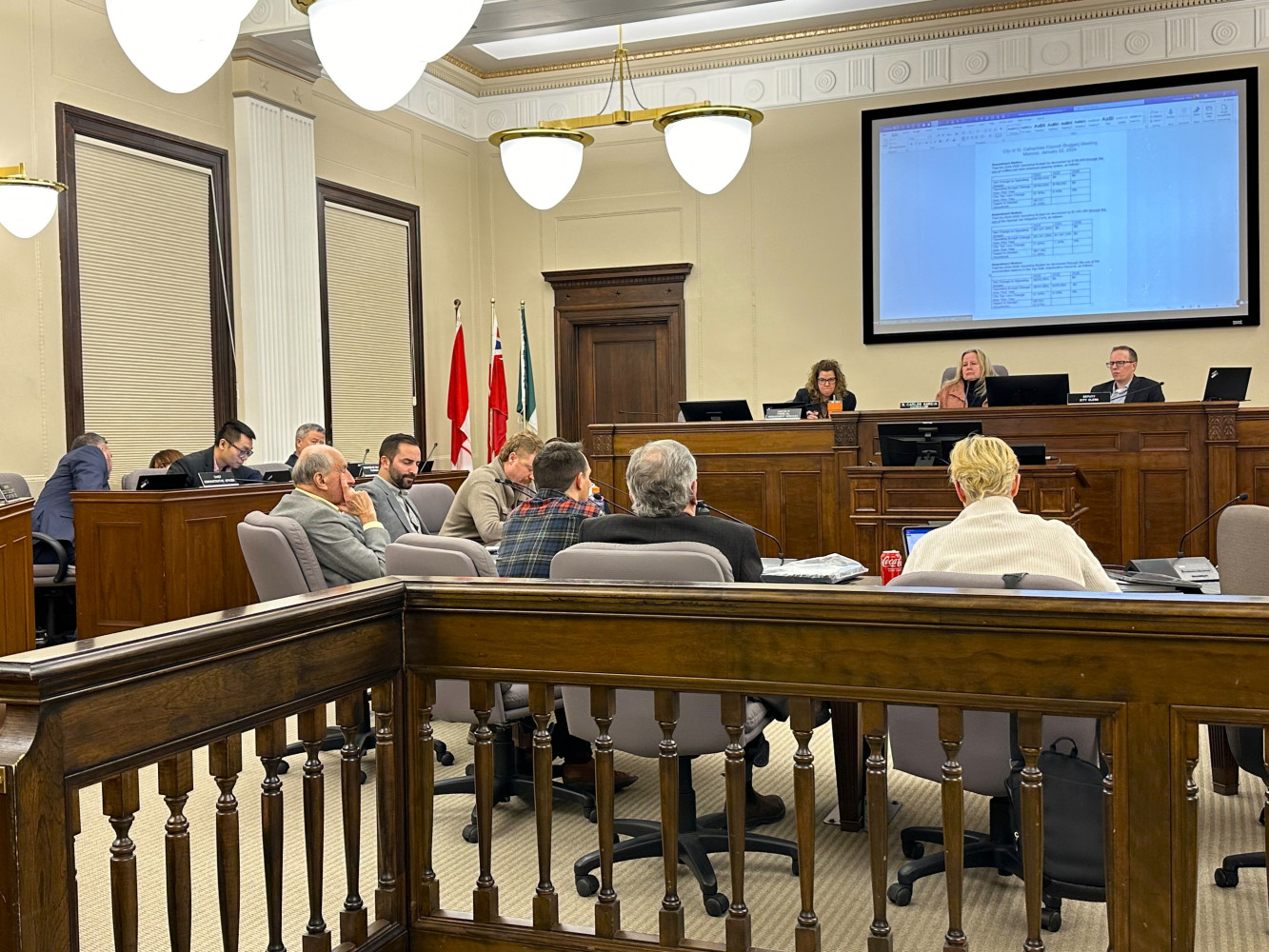
St. Catharines Councillors approve nearly $10K wage increase
Following the approval of a majority of St. Catharines City Councillors on October 7th, the annual wage for elected officials in the municipality will increase to $37,000 in 2026, for the next term of Council. The increase is almost $10,000 more than the $27,030 they currently receive, an almost 35 percent hike.
The staff report—predicting public backlash—noted a council pay raise “is often met with unfavourable public opinion along with apprehensive political conditions.” But the data in an accompanying staff report makes it clear the compensation for St. Catharines elected officials has fallen behind other similar sized municipalities.
St. Catharines Council last considered an increase in 2022, which would have effectively seen the annual wage of a councillor reach $32,684 (based on 2019 average income) by 2026. The related motion was narrowly defeated at the time by a 6-5 vote.
In March 2023, Councillor Kevin Townsend (Ward 3 - St. George’s) moved a motion directing staff to prepare terms of reference “for a citizens task force to review remuneration for Council, boards, agencies, and commission.” During the 2022 debate, Councillor Joe Kushner (Ward 2 - St. Andrew’s), who voted against the raise at the time, had suggested that any remuneration review should be done by a residents’ committee and not be a council-lead process.
A task force was eventually populated with four community members, with experience in human resources, finance and compensation methodology, who, with the assistance of staff, reviewed the 2022 report; updated wage and benefit data from other municipalities; analyzed the marketplace and formulated the recommendations for Council’s consideration. The task force recommended a $37,000 salary as it was the “mid-point between the average lower tier comparator municipality and the current salary for St. Catharines.”
St. Catharines City staff and the task force looked at the nine comparators: Barrie, Guelph, Kingston, Thunder Bay, Windsor, Cambridge, Kitchener, Oshawa and Waterloo. (Niagara Falls is also part of the regular comparators that St. Catharines uses, but it was included in a separate comparison of all Niagara municipalities in the related staff report).
The list of comparator municipalities was developed in 2015. The staff report at the time noted that Council members would often inquire how St. Catharines compared to other cities in an effort to set benchmarks or in relation to the introduction of a new service or program.
The goal was to list municipalities that “appear to have the most similarities” to St. Catharines. The criteria that led to inclusion on the list included population; size in square kilometres; average household income; mean home value; municipal taxes as a percentage of average income; and the existence of public transit.
With all nine of the municipal comparator councils receiving higher annual wages than St. Catharines, the task force recommended a wage increase. Even with the raise, St. Catharines councillors will still be paid less than their peers, whose salaries range between $42,000 to $63,000 a year.
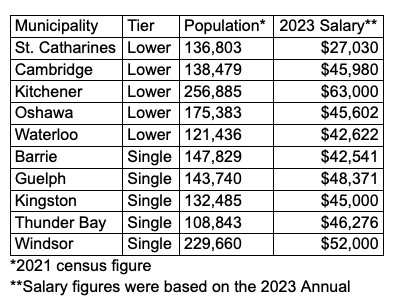
Remuneration reports of St. Catharines comparator municipalities.
But with the list being almost ten years old, are those municipalities still truly comparators with St. Catharines and should other criteria have been considered?
The majority of the comparators are within approximately 10 percent of the population of St. Catharines (136,830, as per the 2021 census), though Kitchener, Windsor and Oshawa range from approximately 175,000 to 257,000 residents and Thunder Bay is approximately 20 percent smaller.
In 2018, the Association of Municipal Managers, Clerks and Treasurers of Ontario (AMCTO) conducted a Councillor Compensation Survey with 257 of Ontario’s 444 municipalities participating. At the time, the majority of Ontario councillors were paid less than $40,000 a year, though those figures have likely increased since 2018. Not surprisingly, the AMCTO survey concluded that the level of compensation that a municipality offered was closely correlated to its population size.
Looking at the comparator municipalities, the two largest— Kitchener and Windsor—have the highest paid councillors, possibly reflecting the higher ratio of residents to councillor.
Not all of the nine “comparable” municipalities to St. Catharines have the same governance structure, which was recognized at the time of the list’s development. Barrie, Guelph, Kingston, Thunder Bay and Windsor, which are single tier municipalities, were included because of “commonalities” shared with St. Catharines. Cambridge, Waterloo, Kitchener and Oshawa are lower tier municipalities like St. Catharines. The number of council members on each council (including the head of Council) range between 8 to 13 members.
With single tier municipalities dealing with additional responsibilities, such as social services, public health and social housing, one might expect those councillors would make more than their lower tier counterparts, however, the staff report indicates that the average annual wage for the comparable single tier municipalities was $43,340, compared to approximately $47,000 per year for lower tier councillors. As noted, the task force “cut the difference” between the latter average and the 2023 rate for St. Catharines councillors.
There was little specific discussion at the October 7th council meeting regarding the discrepancy between the annual wage for St. Catharines councillors and the comparable municipalities. Councillor Caleb Ratzlaff (Ward 4 - St. Patrick's) suggested that the large number of politicians in Niagara Region may factor into the lower average council wage, with other regions spending comparable total amounts on member salaries but divided amongst a small pool of representatives.
The wage increase will have a $118,577 impact on the St. Catharines budget, representing an estimated tax increase of approximately $1.68 or a 0.10 percent increase for the average household based on approved 2024 tax rates.
While the budgetary impact is nominal, St. Catharines ranks “high” in terms of property taxes as a percentage of income. The staff analysis seemed to only look at existing salary levels of councils and not look at the issues of affordability or community affluence.
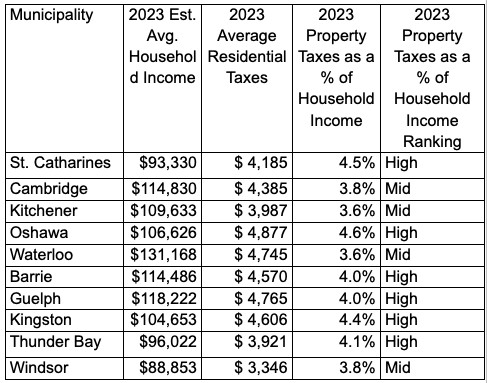
*Source: BMA Municipal Study 2023
For more than 20 years, BMA Consulting Inc., has done an annual municipal comparative study. Some of the criteria in the annual BMA report was considered when staff came up with the list of comparators in 2015.
In the most recent 2023 study, BMA notes that “household income is one measure of a community’s ability to pay”. St. Catharines is on the lower end of the scale when it comes to income-related metrics in relation to its comparators.
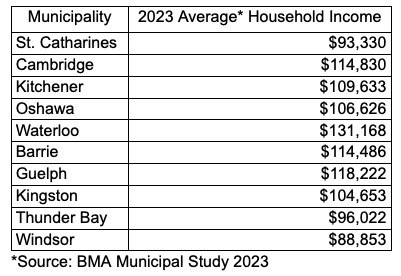
*Source: BMA Municipal Study 2023
Of the comparable municipalities, only Windsor has a lower average household income and, other than Thunder Bay, the rest of the municipalities exceed St. Catharines by more than 10 percent when it comes to average household income.
On whether a municipality is affluent, the BMA study notes, “assessment per capita statistics have been compared to provide an indication of the “richness” of the assessment base in each municipality.” Once again, St. Catharines comes up “low”, along with Windsor and Thunder Bay, when it comes to assessment per capita.
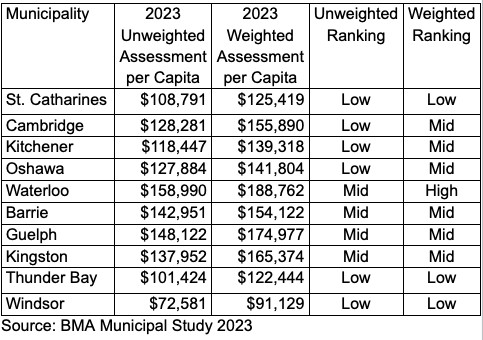
Source: BMA Municipal Study 2023
**From the study, “Unweighted assessment provides the actual current value assessment of the properties. Weighted assessment reflects the basis upon
which property taxes are levied, after applying the tax ratios to the various property classes to the unweighted assessment.
When looking at just “raw” assessment values, St. Catharines falls below the comparable municipalities that had the 2023 information readily available on their websites:
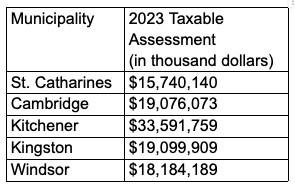
The 2018 AMCTO survey suggested there were regional differences in council wages with Central Ontario Council salaries skewing higher than the Provincial average compared to northern and southwestern municipalities. While Niagara is usually grouped with Central Ontario, it is clear that Niagara municipal councils have taken their cues from other Niagara municipalities when it comes to council member wages.
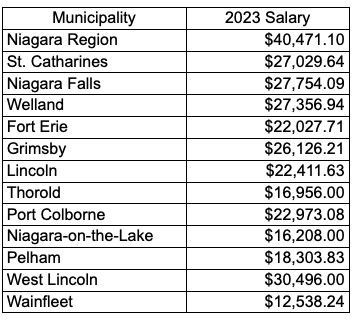
St. Catharines council wages were modestly above the Regional average of $23,413, according to staff’s calculations, but they were in line with the two other most populated municipalities in the region. St. Catharines, Niagara Falls and Welland councillors were all paid roughly the same amount in 2023. Surprisingly, the relatively small Township of West Lincoln topped the three larger municipalities in annual salary and representatives at the upper-tier Niagara Region made approximately $40,000 in 2023.
While there might be an expectation that Regional Councillors would get paid more than their lower-tier counterparts, due to public health and social services responsibilities, Mayor Mat Siscoe disputed such a conclusion.
Siscoe, who served solely as a Regional Councillor for most of 2022, declared that “city councillors work harder than regional councillors.” The Mayor, whose wage is determined separately from councillors, noted he had “no dog in this fight”, nonetheless, he was supportive of the wage increase.
Mayor Siscoe also estimated that Councillors spend “at least 30 hours a week” on their duties. The staff report noted that despite the position being part-time “for many councillors the job has become 24-7.” Councillor Kushner, who has served on St. Catharines City Council since 1976, disagreed.
“There are less responsibilities now. It is not a 24-7 job. I don’t share that…and it is not because I am lazy.”
One of the other justifications for the wage increase espoused by the task force was the hope that a higher wage would “attract a more diverse set of candidates.” A number of councillors had made this argument in 2022 and Councillor Robin McPherson (Ward 4 - St. Patrick's) echoed it during the October 7th meeting.
“Serving the community and doing the job should not have a negative impact on our families. People would really love to run for office and serve the community but cannot afford to. Inadequate remuneration does stand as a barrier.”
Looking again at the list of municipal comparators, the supposition that a higher wage will lead to a more diverse council is not borne out by the data.
Kitchener and Windsor have the highest annual wages of the municipalities but, especially in the latter’s case, the municipal council is almost entirely male, with no BIPOC (Black, Indigenous, People of Colour) representation. While Kitchener does have more female representation, it does not meet gender parity and actually has one less female councillor this term, compared to the previous one. BIPOC representation is minimal or non-existence across the ten municipalities.

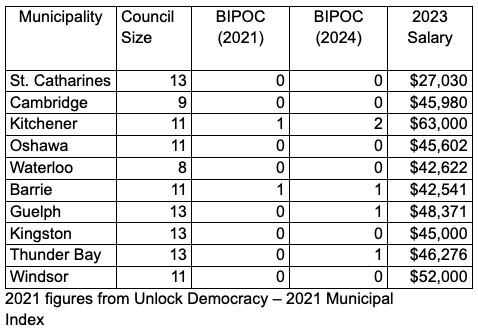
It should be noted that St. Catharines Council wages have not been static, despite the 2022 vote. Council member wage increases (not including the mayor) are tied to a percentage of the average income of all individuals filing a tax return in the City of St. Catharines. The percentage that has been used in recent years has been 55.5 percent. The 2022 vote was to increase the percentage to 71.5 percent, to better bring St. Catharines in-line with the other municipal comparators.
Councillor Kushner felt the methodology had served Council “well” over the years. Staff, however, noted that the methodology had St. Catharines “lagging behind” and recommended that future increases be tied to the economic adjustments provided to non-union staff, a common practice in other municipalities.
The wage increase to $37,000 passed in a 9-4 vote. Four of the councillors that were opposed in 2022, ouncillor Kushner, Councillor Carlos Garcia (Ward 6 - Port Dalhousie), Councillor Bruce Williamson (Ward 6 - Port Dalhousie) and Councillor Dawn Dodge (Ward 5 - Grantham), again voted against the proposed increase. Councillors Bill Phillips (Ward 2 - Grantham) and Matt Harris (Ward 2 - St. Andrew’s), who were opposed in 2022, voted for the increase. They were joined by Mayor Siscoe, Councillors Townsend, McPherson, Ratzlaff, Jackie Lindal (Ward 1 - Merritton), Mark Stevens (Ward 3 - St. George’s) and Greg Miller (Ward 1 - Merritton). The latter indicated that the wage increase will have no impact on him, as he will not be seeking re-election in 2026.
In addition to the 2026 wage increase and change in methodology for future increases, it was approved that councillors be offered the opportunity to join the OMERS pension fund next term. A possible $1,000 per year “healthcare spending account”, will be considered during upcoming budget deliberations and all councillors will receive either a parking pass or bus pass.
Email: [email protected]
At a time when vital public information is needed by everyone, The Pointer has taken down our paywall on all stories to ensure every resident of Brampton, Mississauga and Niagara has access to the facts. For those who are able, we encourage you to consider a subscription. This will help us report on important public interest issues the community needs to know about now more than ever. You can register for a 30-day free trial HERE. Thereafter, The Pointer will charge $10 a month and you can cancel any time right on the website. Thank you
Submit a correction about this story


